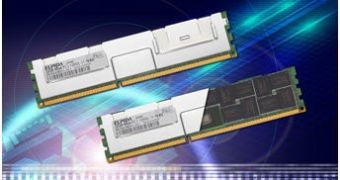It is not often that a company can claim to have outmatched all of its rivals in a certain area, but this is exactly what Elpida seems to have done, at least on the server memory market.
On the desktop market, high-end systems can usually make do with 8 GB of RAM, sometimes even less, while enthusiast-grade machines go as high as 16 GB or even 24 GB.
This is accomplished by placing multiple 4 GB modules in dual-channel or triple-channel configurations.
On the server market, however, things seem to be farther along than on the PC market.
This seems to have been proven beyond any reasonable doubt by Elpida's most recent announcement regarding its memory offer.
Apparently, the company has begun to send out sample shipments of what can be seen as the highest-density memory module created so far.
It is a LRDIMM (Load Reduced Dual In-Line Memory Module) composed of no less than 72 4 Gb chips based on the 40nm manufacturing products.
In other words, the module has a capacity of a full 32 GB, which is more than just significant, especially considering that it uses DDR3 chips.
The frequency of the DDR3 is 1,600 MHz, but what is even more interesting is that, in addition to 1.5V, the newcomer can work on a voltage of 1.35V.
Of course, timings and the frequency itself will be different depending on which voltage is selected. Finally, in order to ensure a stable operation, Elpida threw in a heatspreader.
In the making of the 32GB DDR3, Elpida took advantage of the LRDIMM standard, which allows buffering of the I/O bus line with the memory buffer (MB).
Of course, since only samples are available for now, actual availability is still a way off. The earliest at which Elpida expects mass production to start is the first quarter of 2011.

 14 DAY TRIAL //
14 DAY TRIAL //